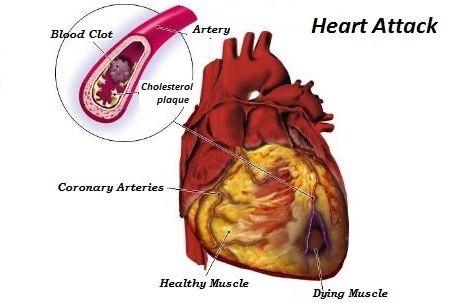Heart Disease Treatment
The heart is the motor that keeps the blood in motion throughout all the blood vessels in the body. In order, for the heart muscle to pump properly, it needs to be nourished by coronary blood vessels. Any disease or blockage of the coronary arteries can deprive the heart muscle with the necessary oxygen and blood it needs for proper function.
A heart attack, medically known as myocardial infarction, is the death of an area of heart muscle caused by the blockage of a coronary vessel. This obstruction of blood flow through one of the branches of the coronary artery is commonly caused by a rupture of an atherosclerotic plaque. Blood flow may be so severely diminished, or totally occluded that a portion of the heart muscle dies.
The most typical symptom of a heart attack is chest pain (angina pectoris) that may radiate to the left arm, neck, and jaw. Other symptoms may include shortness of breath, heat in the chest, anxiety, light headedness, or loss of consciousness.
The major risks factors for a heart attack are diabetes, lack of exercise, high blood pressure, sedentary lifestyle, old age, hypercholesterolemia, obesity, smoking, a high-sodium diet, and genetic predisposition.
In January, you may have noticed TV commercials addressing heart attack prevention. This is because most heart attacks occur during the month of February.
There are five tests that can detect a heart attack:
Electrocardiogram (ECG)
Coronary angiography
Exercise stress test
Nuclear scan
Blood test
Heart Attack Prevention Diet
Restrict sodium intake.
Avoid foods high in trans fatty acids and saturated fats.
The heart is the motor that keeps the blood in motion throughout all the blood vessels in the body. In order, for the heart muscle to pump properly, it needs to be nourished by coronary blood vessels. Any disease or blockage of the coronary arteries can deprive the heart muscle with the necessary oxygen and blood it needs for proper function.
A heart attack, medically known as myocardial infarction, is the death of an area of heart muscle caused by the blockage of a coronary vessel. This obstruction of blood flow through one of the branches of the coronary artery is commonly caused by a rupture of an atherosclerotic plaque. Blood flow may be so severely diminished, or totally occluded that a portion of the heart muscle dies.
The most typical symptom of a heart attack is chest pain (angina pectoris) that may radiate to the left arm, neck, and jaw. Other symptoms may include shortness of breath, heat in the chest, anxiety, light headedness, or loss of consciousness.
The major risks factors for a heart attack are diabetes, lack of exercise, high blood pressure, sedentary lifestyle, old age, hypercholesterolemia, obesity, smoking, a high-sodium diet, and genetic predisposition.
In January, you may have noticed TV commercials addressing heart attack prevention. This is because most heart attacks occur during the month of February.
There are five tests that can detect a heart attack:
Electrocardiogram (ECG)
Coronary angiography
Exercise stress test
Nuclear scan
Blood test
Heart Attack Prevention Diet
Restrict sodium intake.
Avoid foods high in trans fatty acids and saturated fats.
Eat a well-balanced, high-fiber diet based on whole grains, legumes, fruits, and vegetables.
Eliminate the consumption of refined foods.
Diagnosis of Heart Attack
Heart attacks do not respect time, place or circumstances. These can happen to anyone, anytime, and apparently out of the blue, perhaps even depriving the unsuspecting victim of life.
Pain
The first symptom of heart attack, in a majority of the cases, is a severe and prolonged pain in the middle of the front of the chest. In some, the pain may be severe enough to be described as the worst pain the patient has ever experienced. The pain is often accompanied by weakness, sweating, nausea, vomiting, giddiness and anxiety.
Shock While pain is the most prominent symptom in most of the cases of heart attack, there are cases in which this is not so. The first and the most prominent symptom may be a state of shock in which the patient at once passes.
He suddenly experiences weakness which slowly or rapidly may develop into intense prostration or collapse. He may unexpectedly slump if he is standing or walking. He may lose consciousness because of less blood going to the brain.








0 comments:
Post a Comment